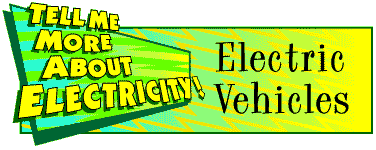 |
 Electric
Vehicles (EVs) run on electrical energy instead of gasoline or diesel
fuel. Thousands of EVs are on the road today. They are popular for many
reasons:
Electric
Vehicles (EVs) run on electrical energy instead of gasoline or diesel
fuel. Thousands of EVs are on the road today. They are popular for many
reasons:
- EVs help reduce pollution.
- EVs cost less to run than gasoline vehicles.
- EVs reduce our dependency on gasoline.
- EVs do not need motor oil or antifreeze and do not need belts, hoses, filters, and pumps.
How EVs Work
Like gasoline tanks, batteries store the fuel used to operate an EV. EV batteries can be charged by plugging the vehicle into a charging station. The batteries store the electricity until the vehicle is driven.
Under the hood, an EV consists of an electric motor, one or more controllers, and batteries. The controller governs the amount of electricity that flows from the batteries to the motor when the driver steps on the accelerator. The motor changes electrical energy from the batteries to mechanical energy, which makes the vehicle move.
EVs and the Environment
Gasoline- and diesel-fueled vehicles produce about half of the pollution in large North American cities. Electric vehicles offer a non-polluting alternative. Even when pollution related to power plant electricity production is factored in, EVs generate less air pollution than gasoline- and diesel-fueled vehicles.
For every mile travelled in an EV instead of a gasoline vehicle, the following pollutants are reduced:
- Carbon monoxide, nitrogen oxide, and volatile organic compounds, all of which are key ingredients in smog.
- Carbon dioxide, which is not an air pollutant but may contribute to the possible risk of global warming.
EV Efficiency
Vehicle efficiency is measured by how much of the energy a vehicle uses actually makes the wheels move. An EV is about four times more efficient than a gasoline vehicle.
If you factor in the energy used in creating gasoline at a refinery or electricity at a power plant, EVs are still twice as efficient as gasoline vehicles.
Unlike a gasoline vehicle, when an EV is stopped in traffic, it doesn't use fuel just to keep the motor running, and this reduces fuel consumption. Additional efficiency is created by something called "regenerative braking." When an EV slows down, the motor continues to turn, but the power no longer flows to the wheels. Instead it's fed back to the batteries, giving them a small charge every time the driver stops or goes downhill.
![]() Next:
Energy Efficiency
Next:
Energy Efficiency![]()
![]() Previous:
Pioneers of Electricity
Previous:
Pioneers of Electricity ![]()